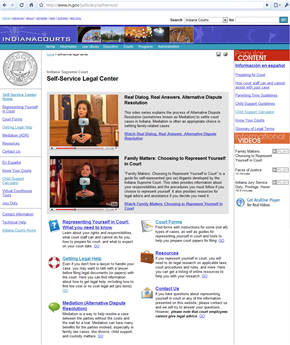 Almost every trial judge knows that there is a growing number of litigants who represent themselves in court, either by choice or because they cannot afford to hire attorneys. In 2008, more than 400,000 people represented themselves in Indiana trial courts. Those individuals may go to court without the benefit of an attorney, but that doesn’t mean the self-represented litigant must do so without some guidance. The Indiana Supreme Court is aware that self-represented litigants often look first to our trial courts and clerks for answers to their legal questions.
Almost every trial judge knows that there is a growing number of litigants who represent themselves in court, either by choice or because they cannot afford to hire attorneys. In 2008, more than 400,000 people represented themselves in Indiana trial courts. Those individuals may go to court without the benefit of an attorney, but that doesn’t mean the self-represented litigant must do so without some guidance. The Indiana Supreme Court is aware that self-represented litigants often look first to our trial courts and clerks for answers to their legal questions.
To alleviate the pressure on trial courts, and to help self-represented litigants better navigate a challenging process, the Indiana Supreme Court continues to upgrade and improve the Court’s online self service legal center. The self service legal center was originally created in October 2001. The most notable improvement to the site is the transformation of online forms into user-friendly interactive documents.
The old site required a user to download and print forms, including several pages of instructions created as a guide for the proper line-by-line completion. While helpful in providing some guidance, courts would invariably receive unnecessary, or incomplete, pleadings.
Self-represented litigants using the updated site now have access to documents that include an automatic-fill feature. The forms are designed to be fill-in style questionnaires that are written in plain English, not “legalese.” When the user answers a question, the information is automatically inserted into the appropriate location throughout the form. This saves time for the user and increases the accuracy of the completed documents. Court staff are not permitted to give legal advice, but they must check pleadings for accuracy. Now they can refer self represented litigants to the improved online self service legal center as a resource. While the online documents promote greater accuracy, new, printable forms are also in development. These forms will be an updated version of the former printable forms with instruction, but designed to maintain greater accuracy and completeness.
The website prominently features a video, Family Matters: Choosing to Represent Yourself in Court, which provides information about the self-represented litigant’s responsibilities and the court procedures the litigant will be required to follow. It also provides resources for finding an attorney, doing legal research, and information on mediation and alternative dispute resolution.